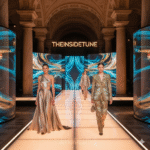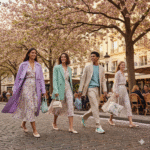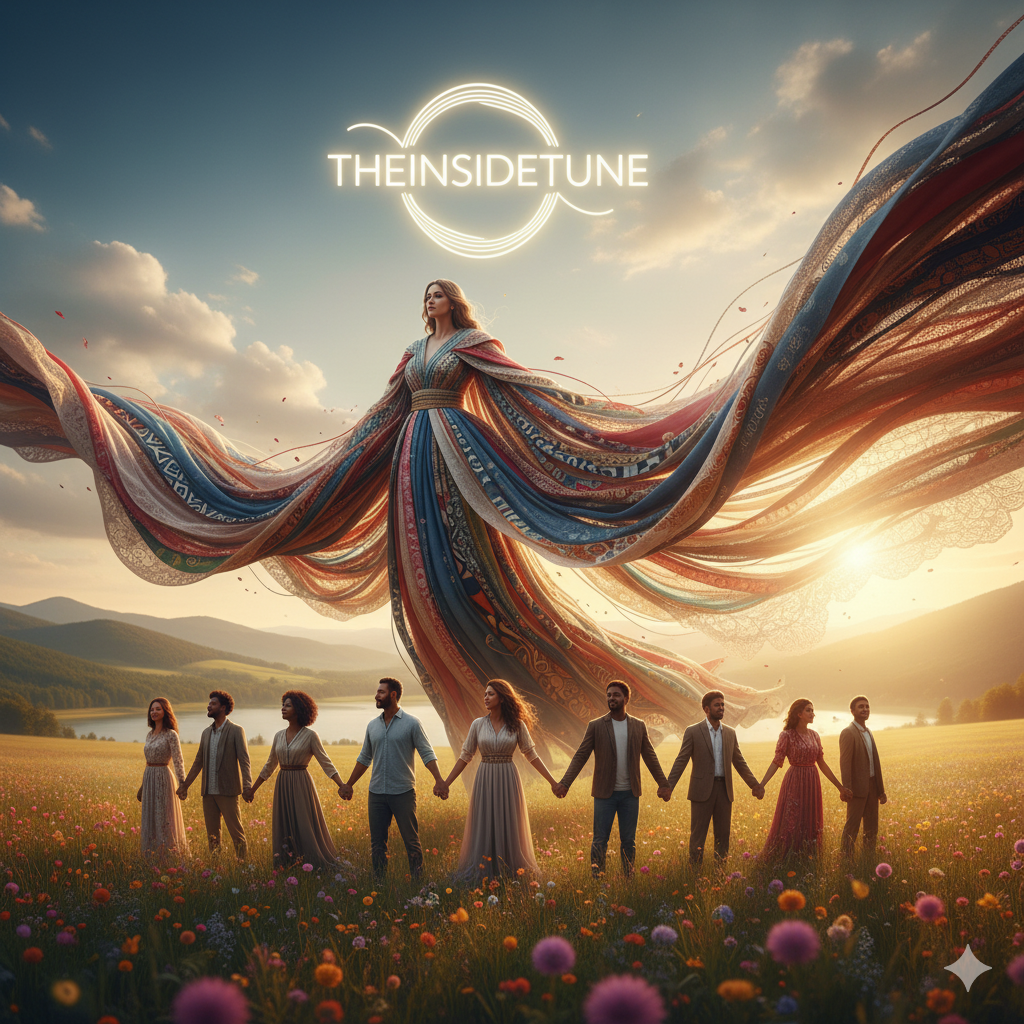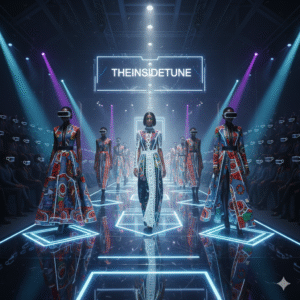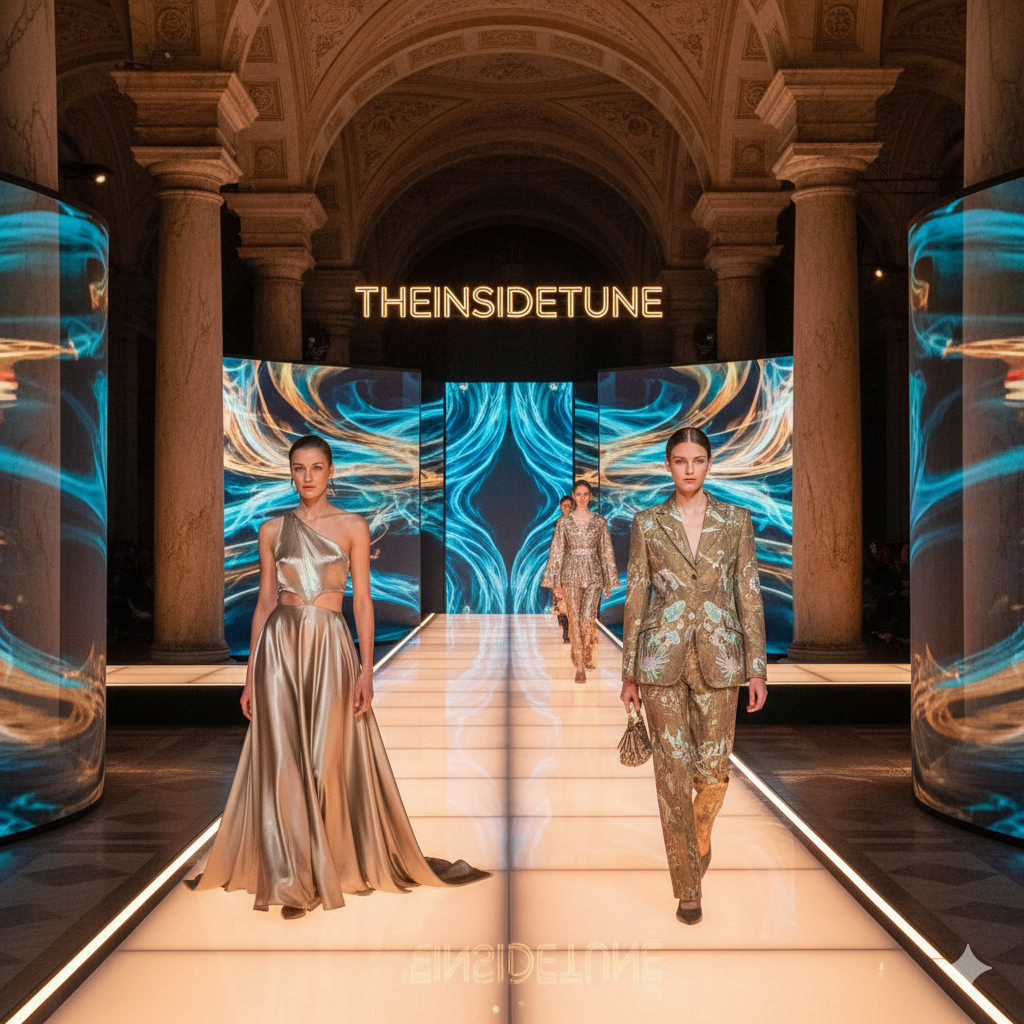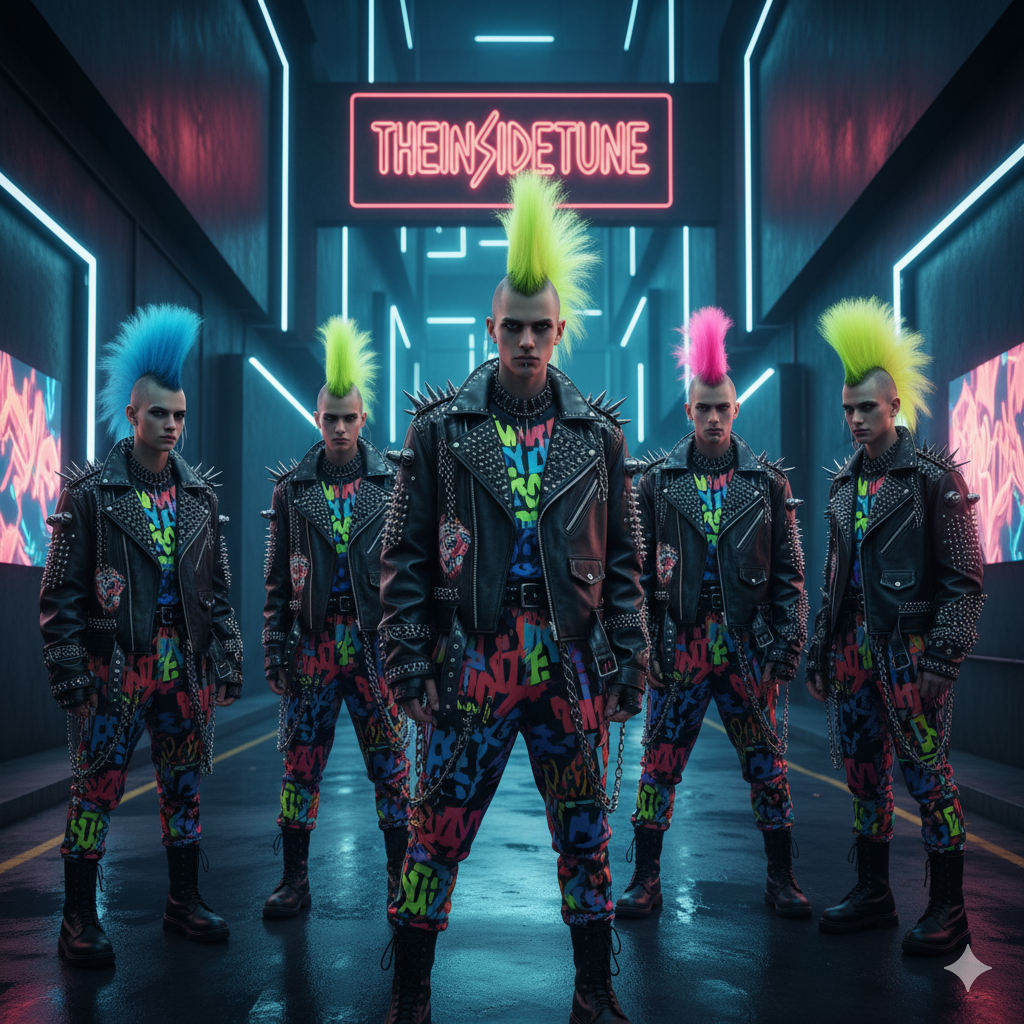🌍✨ Multicultural Future of European Style 2025; Cultural Diversity Influence in European Fashion 2025
👗 Introduction: Fashion as a Language of Cultures
Fashion has always been more than fabric, buttons, or a quick trip to Zara. It’s a language—a way humans speak without words, a visual diary of identity, community, and dreams. Every hemline, every color, every pattern whispers a story.
And in 2025, European fashion is louder, richer, and more diverse than ever. Walk through the streets of Paris, Milan, Berlin, or London, and you’ll notice it: hijabs paired with Balenciaga sneakers 👟, African Ankara prints styled with Dior blazers 💼, kimono-inspired jackets worn over ripped jeans. Fashion today is fusion. It’s culture meeting culture, blending histories, and reimagining futures.
But here’s the twist 👉 cultural diversity in fashion is no longer just “inspiration” or “a trend.” In 2025, it’s structural. It influences who becomes a designer, which fabrics get sourced, who walks the runway, and how brands tell their stories.
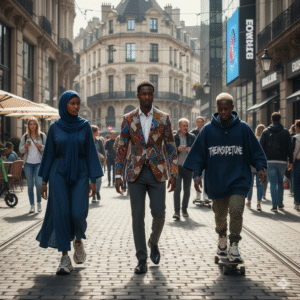
🌸 Why This Blog Matters
This blog is for the dreamers and observers, the ones who know that when a Nigerian textile shows up on a Paris runway, or when a Turkish designer leads a Milan collection, that’s not just fashion—that’s history in motion.
We’ll explore:
-
How Europe’s history of migration, colonization, and globalization shaped today’s fashion DNA.
-
Why cultural diversity is driving everything from haute couture shows to TikTok streetwear trends.
-
Examples from real, trending 2025 shows—like Pharrell’s Louis Vuitton UNESCO runway 🌐, Burberry’s crochet-heavy festival chic 🎶, and Gucci’s bold new direction under Demna 🔥.
-
The challenges: appropriation vs appreciation, sustainability, and authenticity.
-
What’s next: how AI, tech, and youth culture will redefine fashion’s multicultural future.
💡 A Quick Thought
Think of fashion as a mirror. For centuries, it reflected mostly a narrow Eurocentric gaze. But today, the mirror is cracked into a kaleidoscope—every shard reflecting a different culture, a different story, a different kind of beauty. That’s what makes 2025 so exciting. 🌈
✨ In short: European fashion in 2025 is a global conversation stitched into fabric. Every runway, every boutique, every street corner is proof that diversity isn’t decoration anymore—it’s the heartbeat of style.
🕰️ Historical Context – Europe, Empire & the Legacy of Cross-Cultural Exchange
👘 Why History Matters in Fashion
Before we jump into 2025’s colorful runways, let’s pause and rewind. Fashion is like a diary—it remembers things, even the messy parts. And Europe’s fashion identity has been shaped (sometimes beautifully, sometimes painfully) by centuries of cross-cultural encounters.
To truly understand why Burberry is crocheting festival-inspired dresses 🎶, or why Louis Vuitton is staging global-themed runways 🌍, we need to go back—to empires, migrations, revolutions, and the everyday lives of people who carried their clothing traditions across borders.
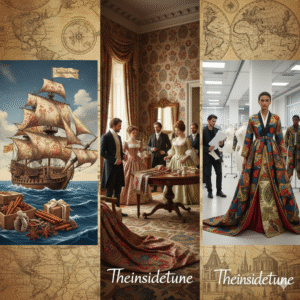
🏛️ Colonial Europe: The First Fashion Crossroads
Let’s be real—Europe’s cultural diversity story isn’t all sunshine and collaboration. A lot of it starts with colonialism.
-
Spices, silks, and cotton: European empires—Britain, France, Spain, Portugal, the Netherlands—expanded across Africa, Asia, and the Americas. They didn’t just bring back spices and gold; they shipped back fabrics, patterns, dyes, and weaving techniques. Imagine: cotton from India 🌿, indigo dye from West Africa 💙, silk from China 🐛. These became staples of European luxury.
-
Exoticism in dress: In the 18th and 19th centuries, wealthy Europeans loved to flaunt “exotic” fashion influences—think Turquerie (Ottoman-inspired gowns 🕌), Chinese silk robes, or African beadwork. But often, these were stripped of context, used as novelties rather than respected cultural symbols.
-
Unequal exchanges: Behind every Parisian lady in a hand-dyed Indian muslin dress was a story of colonial trade routes, exploited labor, and silenced artisans. This imbalance still echoes in conversations today about cultural appropriation.
👉 So, from the very beginning, European fashion was global—but not always in fair or ethical ways.
🚶♀️ Post-War Migration & Diaspora Influence
Fast forward to the mid-20th century. After World War II, Europe rebuilt itself, and waves of migration changed its cultural DNA.
-
London & the Caribbean: The Windrush generation (Caribbean migrants to Britain 🇯🇲) brought not only reggae and steelpan but also bold prints, headwraps, and tailoring styles that would eventually influence British streetwear and music-inspired fashion.
-
Paris & North Africa: France welcomed migrants from Algeria, Morocco, Tunisia 🇲🇦. Their flowing djellabas, kaftans, intricate embroidery, and vibrant markets quietly infused Paris with a new style vocabulary. By the 1970s, Yves Saint Laurent was openly drawing on Moroccan design.
-
Germany & Turkey: Turkish gastarbeiter (guest workers 🇹🇷) in Germany carried traditions of modest fashion, headscarves, and textile craftsmanship. Decades later, Berlin became a hub for edgy, multicultural streetwear where Turkish and German youth mix styles.
-
Italy & Africa: Rome and Milan saw increased African migration, adding a new dimension to tailoring and colorful street style that now appears even in high fashion shows.
👗 What’s magical is how second and third generations took these traditions and remixed them with European aesthetics. The children of migrants grew up navigating two worlds—and their wardrobes reflected exactly that.
🎨 Modernism, Avant-Garde & Global Inspirations
The 20th century wasn’t just about migration—it was also about art and rebellion. Designers and artists looked outside Europe for fresh ideas.
-
Bauhaus & Japanese minimalism: European modernists admired Japanese silhouettes and simplicity. This admiration birthed minimal fashion aesthetics we still see in brands like Jil Sander and COS.
-
Surrealists & “primitive” art: Artists like Picasso and fashion designers like Paul Poiret borrowed African masks, Asian drapes, and Middle Eastern patterns—often without crediting their origins.
-
1960s–70s counterculture: Hippies wore Indian kurtas, Afghan coats, Moroccan kaftans, and Native American-inspired fringe. Woodstock fashion 🌻 was basically a global thrift shop—though again, often stripped of cultural meaning.
🛒 Globalization & Fast Fashion Era
Then came the 1990s–2010s: the fast fashion explosion.
-
Brands like H&M, Zara, Mango, and Topshop mass-produced looks that “borrowed” motifs from anywhere—Maasai beadwork one season, Japanese cherry blossoms the next 🌸, Aztec prints the season after.
-
But behind the cheap price tags were garment workers in Bangladesh, India, or Cambodia, paid little and working in unsafe factories. 🌍💔
-
Globalization meant more cultural mixing in everyday wardrobes—but it also raised louder questions: who benefits? Who gets erased? Who gets credit?
✨ The Stage for 2025
All of this—colonial legacies, diaspora waves, avant-garde inspirations, fast fashion shortcuts—set the stage for where we are today.
By 2025:
-
Europe is one of the most multicultural regions in the world.
-
Fashion designers are no longer just “borrowing”; many are from the very cultures once “borrowed from.”
-
Consumers are more vocal 🗣️, demanding ethical sourcing, authentic storytelling, and real representation on the runway.
-
Diversity isn’t just aesthetic—it’s becoming structural, slowly reshaping the fashion industry from the inside out.
Drivers of Cultural Diversity in 2025 Fashion
🌍 Why Diversity is Booming in 2025
Fashion doesn’t change randomly. Every hemline, every new pattern on a runway is tied to bigger forces: society, technology, politics, even TikTok trends.
In 2025, the reason cultural diversity is blooming in European fashion isn’t just that designers “like it.” It’s because multiple forces—globalization, migration, social media, consumer voices, sustainability movements, and tech—are converging at once.
-
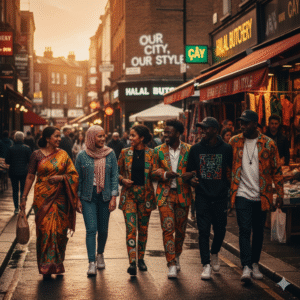
Multicultural Future of European Style 2025| Amazing Facts by Theinsidetune Let’s unpack them one by one 👇
🌐 Globalization & Diaspora: The World Wears Europe, and Europe Wears the World
If you walk through a city like London today, you’re basically walking through the world. Turkish kebab shops 🥙 next to Caribbean reggae clubs 🎶 next to Indian curry houses 🍛, with second-generation kids mixing Nike Air Force 1s with saris or djellabas.
Fashion naturally reflects this:
-
Hybrid Identities: Designers with mixed heritage are reinterpreting their roots. Think of someone like Mossi Traoré in Paris (French-Malian) who mixes banlieue street style with African and South Asian influences. Or Grace Wales Bonner (British-Jamaican) who fuses European tailoring with Afro-Caribbean aesthetics.
-
Streetwear as the new global dialect: In 2025, streetwear is no longer just American hip-hop inspired. It’s Nigerian prints on hoodies, Japanese calligraphy on sneakers, Palestinian keffiyeh patterns in jackets, all remixing in Berlin, Milan, and London.
-
Diaspora Pride: Instead of hiding heritage, younger generations wear it loud and proud. A Somali girl in Copenhagen rocks her abaya with Balenciaga slides. A Pakistani boy in London wears a kurta under a leather biker jacket. And yes, they post it on TikTok 📱—where millions see it and get inspired.
👉 Globalization doesn’t erase culture; it multiplies it. And European fashion is now a melting pot of melting pots.
📱 Digital Culture & Social Media: Fashion Without Borders
Once upon a time, fashion was gatekept. Only those who could attend Paris Fashion Week or buy Vogue had access. Today? TikTok, Instagram, and even AI design tools have blown the doors wide open 🚪.
-
Instant Inspiration: A Nigerian fabric trend can go viral on TikTok today and show up on a Milan runway in six months. 🌈
-
Influencers as cultural ambassadors: Think of Somali-British model Muna Jama or hijabi influencer Leena Al Ghouti—their styles ripple across Europe, proving modest fashion is high fashion.
-
Digital Activism: When a brand misuses cultural motifs (say, turning a sacred Indigenous headdress into a festival accessory), Twitter and TikTok call them out instantly. Brands can’t get away with “exotic inspiration” without accountability anymore. 🔥
Even AI plays a role. Designers now use AI image generators to prototype looks. That means an Indian sari pattern or a Peruvian textile might show up in a designer’s prompt. The question is: are they doing it respectfully? Or just aesthetically? 🤔
👉 Social media has made fashion global, accountable, and faster than ever before.
🌱 Sustainability, Ethics & Artisanship: A Return to Roots
Let’s face it: fast fashion broke trust. Cheap clothes, sweatshops, environmental damage—consumers are done. In 2025, a new value system is emerging: buy less, buy better, buy meaningful.
And guess what? Cultural diversity fits perfectly here 💡.
-
Heritage Techniques: Hand-woven Indian khadi cotton, West African kente weaving, Peruvian alpaca wool, Palestinian tatreez embroidery—these aren’t just textiles. They’re centuries-old knowledge systems. When designers collaborate with artisans, they revive heritage and offer sustainable alternatives to mass production.
-
Fair Trade Fashion: European brands are working directly with artisan groups in Ghana, Morocco, and Vietnam, paying fairly and ensuring communities thrive. ✨
-
Storytelling as Value: Consumers love knowing “who made my clothes.” Wearing a jacket hand-embroidered by women in Pakistan’s Sindh region feels more powerful than a nameless Zara piece.
👉 Sustainability isn’t just green 🌿—it’s cultural, ethical, human. Diversity and sustainability are becoming inseparable.
🌈 Inclusivity, Representation & Identity Politics: Who Gets to Be Seen?
Fashion is not just what you wear—it’s who gets to wear it, and who gets to design it.
In 2025, Europe is facing its identity head-on. Migration, nationalism, racism, gender politics—they’re all part of the conversation. And fashion is where people push back and reimagine identity.
-
Representation on Runways: It’s not unusual now to see hijabi models, models with vitiligo, plus-size models, Black and Asian faces leading Paris and Milan shows. Think of Adut Akech, the South Sudanese-Australian model who has become a European runway queen 👑.
-
Queer & Gender Fluid Fashion: Cultural diversity isn’t just about ethnicity. It’s also about gender expression. Designers are rethinking garments across cultural lines—kaftans, sarongs, kimono—many of which were always gender-fluid in their original contexts. In 2025, these are celebrated openly. 🏳️🌈
-
Designers as Activists: Someone like Priya Ahluwalia (British-Indian-Nigerian) doesn’t just design clothes. She tells stories about diaspora, sustainability, and cultural pride through her collections.
👉 Representation is no longer a “trend.” It’s the backbone of fashion credibility in 2025.
🤖 Technology & AI: The New Cultural Mediators
Here’s the futuristic twist: technology isn’t just a tool, it’s a culture carrier.
-
Virtual Runways: Post-COVID, digital shows became normal. In 2025, some are staged in metaverses or livestreamed on TikTok. A kid in Lagos can watch Paris Fashion Week in real time. 🌍💻
-
AI Design Tools: Fashion houses use AI to explore cultural patterns—sometimes beautifully (reviving lost motifs), sometimes problematically (ripping cultural data without credit).
-
Customization: With digital fashion, you can now buy virtual outfits for your avatar inspired by Ghanaian textiles or Indian block prints, worn in Fortnite or Roblox. Fashion isn’t limited to fabric anymore—it’s pixels, too. ✨
👉 Tech is a double-edged sword. It can democratize culture or erase it. The difference depends on intent.
✨ Wrap-Up of Section 3
So, what drives cultural diversity in European fashion today?
-
🌍 Globalization & diaspora = hybrid styles and identities.
-
📱 Social media = instant inspiration + accountability.
-
🌱 Sustainability = revival of heritage crafts and artisan voices.
-
🌈 Inclusivity = more faces, bodies, and identities on stage.
-
🤖 Tech = a new cultural frontier, both exciting and risky.
-
Key Trends in European Fashion Reflecting Cultural Diversity (2025)
👗 Fashion as a Mirror of Diversity
Walk into a café in Paris ☕, and you might see a girl wearing a Moroccan-inspired kaftan over a vintage leather jacket. In Berlin, a Turkish-German designer is selling sneakers with embroidery patterns drawn from Ottoman art 🕌. In Milan, Gucci’s runway is blending Italian monograms with global textures 🌍.
Fashion in 2025 is a kaleidoscope. The trends aren’t random—they are visual proof of cultural mixing, migration, and identity pride. Let’s explore the key ones making waves right now.
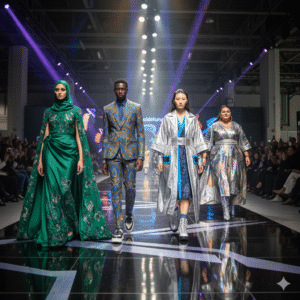
🧵 1. Fusion of Traditional Textiles & Techniques
This trend is everywhere. European designers aren’t just inspired by global textiles—they’re actively collaborating with artisans.
-
African Prints x European Silhouettes: Bold Ankara and Kente fabrics in tailored blazers, pencil skirts, and trench coats. Imagine Burberry’s iconic trench in Ghanaian kente cloth 👑.
-
South Asian Craft in Western Cuts: Indian block prints 🌸 on midi dresses, chikankari embroidery on denim jackets, mirror work on luxury handbags.
-
Japanese Influence: Kimono sleeves reinterpreted in everyday wear, shibori tie-dye techniques on Parisian runways, origami folds used in avant-garde gowns.
-
Latin American Weaving: Bright Andean patterns woven into scarves, ponchos turned into chic oversized coats for the Milan winter.
👉 Example: Ahluwalia (British-Indian-Nigerian designer) creates patchwork jackets made from recycled saris and African prints, turning upcycled heritage into luxury.
✨ Why it matters: These aren’t “costume-y.” They’re everyday, wearable, stylish. It’s tradition reimagined—not erased.
⚧️ 2. Gender Fluidity & Hybrid Forms
Fashion has always loved bending gender rules, but in 2025, cultural diversity makes it even more exciting.
-
Kaftans & Djellabas as Unisex Staples: Once linked to Middle Eastern & North African traditions, now worn by men, women, and everyone in between on European streets.
-
Sarongs & Wraps: South Asian lungis and Southeast Asian sarongs are reimagined as summer skirts in Berlin and Barcelona 🌞.
-
Hybrid Cuts: Jackets with kimono sleeves, trousers with sari-inspired draping, shirts with dashiki necklines.
👉 Example: Palomo Spain, known for flamboyant gender-fluid fashion, has taken inspiration from flamenco + Middle Eastern silhouettes, creating outfits that blur gender and cultural boundaries.
✨ Why it matters: It shows how cultural dress traditions—many of which were never strictly “male” or “female”—are liberating modern European fashion.
🌈 3. Bold Colours, Patterns & Ornamentation
Minimalism had its decade. Now it’s all about colour, story, and symbolism.
-
African Vibes: Vibrant yellows, oranges, and reds dominate streetwear collections.
-
South Asian Brights: Hot pinks 💖, turmeric yellows 💛, and peacock greens 🦚 have stepped straight out of Delhi weddings into Milan runways.
-
Middle Eastern Geometrics: Intricate Islamic-inspired patterns are appearing in scarf prints and jewelry.
-
Latin American Joy: Mexican floral embroidery 🌺, Peruvian stripes, Brazilian carnival sparkle in everyday European accessories.
👉 Example: Pharrell’s Louis Vuitton UNESCO show (2025) used a rainbow palette inspired by global skin tones 🌈—a literal celebration of diversity in colour.
✨ Why it matters: Colours aren’t just shades—they’re cultural codes. Wearing them is celebrating identity.
🎭 4. Runway Presentation as Cultural Storytelling
Runways are no longer just models walking back and forth. They’re experiences, and cultural storytelling is front and center.
-
Music & Dance: Afrobeat performances, Sufi music, or reggaeton beats on European runways.
-
Cultural Spaces: Louis Vuitton using UNESCO 🌍, Dior staging shows in Marrakesh’s desert, or Prada featuring African drummers in Milan.
-
Casting Diversity: Models of all skin tones, ages, religions, and body types. A hijabi model in couture isn’t shocking anymore—it’s celebrated.
-
Narratives: Designers now explain collections: “This embroidery is from artisans in Gujarat, India. This silhouette is inspired by Somali wedding dresses.”
👉 Example: Gucci under Demna (2025) turned its debut into cinematic storytelling, blending Italian heritage with global backdrops.
✨ Why it matters: Storytelling makes fashion more than fabric—it makes it culture.
🤖 5. Tech Meets Tradition
Here’s the futuristic trend: blending the oldest traditions with the newest tech.
-
AI Pattern Revival: Designers use AI to reconstruct ancient patterns (like Mayan textiles or lost Ottoman motifs) and then bring them to life in fabric.
-
AR & VR Shows: You could be in Lagos or Dhaka and attend Paris Fashion Week via VR glasses 👓.
-
Digital Heritage: Avatars in the metaverse wearing kimonos, Ankara prints, or embroidered abayas.
👉 Example: Smaller European brands now collaborate with artisan communities in Morocco and digitize their embroidery into VR fashion for gaming platforms.
✨ Why it matters: This ensures traditions don’t die—they adapt and evolve.
🧡 Section Wrap-Up
So, what do we see on Europe’s streets and runways in 2025?
🌍 A fusion of global textiles and local tailoring.
⚧️ Gender-fluid styles rooted in cultural traditions.
🌈 Explosions of colour and patterns carrying deep heritage.
🎭 Runways turning into cultural storytelling events.
🤖 Tech helping old traditions find new life.
Case Studies – Brands, Designers & Shows Leading the Way
🌍 Why Case Studies Matter
Talking about “cultural diversity” in general is inspiring, but sometimes it feels vague. The real proof is in the runways, the collections, and the designers who are changing the game. These stories are where the abstract becomes visible.
In 2025, Europe’s fashion capitals—Paris, Milan, London, Berlin—are not just echo chambers of Eurocentric style anymore. They’re vibrant stages where African, Asian, Middle Eastern, and Latin American influences shine alongside European traditions.
Let’s break it down through some standout examples 👇
🎶 Louis Vuitton (Pharrell Williams, Paris 2025)
When Pharrell Williams took over as creative director of menswear at Louis Vuitton in 2023, the fashion world was curious. By 2025, he’s proven one thing: he is serious about diversity.
The UNESCO Show (2025): Pharrell staged a runway in partnership with UNESCO, highlighting cultural heritage 🌐. Instead of a typical Parisian palace, models walked through an installation celebrating global crafts.
Clothing & Symbols: His collection used African wax prints, Caribbean reggae-inspired tailoring, and Native American beadwork influences—always credited and contextualized.
Diverse Casting: The runway was packed with models of all shades, sizes, and genders. Pharrell even included artisans from partner communities in the presentation.
👉 Why it’s powerful: Pharrell isn’t just “borrowing aesthetics.” He’s building bridges between fashion and cultural preservation.
✨ Human Moment: Viewers described the show as “like traveling the world without leaving Paris.” 🌍✈️
🧶 Burberry (Festival Crochet & Cultural Fusion, London 2025)
Burberry, once synonymous with trench coats and tartans, is now shaking up its DNA.
The Crochet Revolution: For summer 2025, Burberry debuted a line of festival-ready crochet pieces inspired by Caribbean and African diasporic traditions. Think bold knits, reggae-inspired colour palettes, and playful textures. 🌈
British Meets Global: They paired traditional Scottish tartans with Jamaican prints, symbolizing London’s real streets where cultures collide daily.
Campaigns: Instead of glossy studio shoots, Burberry photographed its new line in Brixton, London—a neighborhood rich in Caribbean history.
👉 Why it’s powerful: Burberry redefines what “British fashion” means. It’s no longer about monarchy and countryside—it’s about multicultural London and beyond.
✨ Human Moment: A Jamaican-British model described wearing Burberry’s new collection as “finally seeing my roots in a brand I grew up admiring.” 🖤💛💚
🔥 Gucci (Demna’s Bold New Direction, Milan 2025)
Gucci, under Demna Gvasalia (yes, the same Demna from Balenciaga fame), has gone bold with cultural storytelling.
Global Mashup: His debut 2025 Gucci show mixed Italian tailoring with Middle Eastern kaftan silhouettes, South American poncho drapes, and Asian floral embroidery.
Runway Experience: The show was set up like a multicultural marketplace, with food stalls, live music, and artisans working on-site. 🛍️🎶
Streetwear Fusion: Gucci sneakers now feature Peruvian-inspired woven stripes and Japanese manga prints.
👉 Why it’s powerful: Gucci is rebranding from “eccentric luxury” to “luxury as global village.”
✨ Human Moment: Critics said the show felt “like Milan shook hands with the world.” 🤝🌍
✨ Wales Bonner (Grace Wales Bonner, London/Paris 2025)
Grace Wales Bonner is one of the most important voices in culturally diverse fashion today. Her work is deeply rooted in her Jamaican-British heritage.
Storytelling Through Tailoring: Bonner blends Savile Row–style British tailoring with Afro-Caribbean aesthetics, jazz-era references, and Black spiritual traditions. 🎷
Collaborations: In 2025, she launched a collab with Adidas rooted in African football culture—reviving vintage jerseys with modern flair ⚽.
Academic Depth: Her collections often reference history books, archives, and diasporic intellectuals. It’s fashion with footnotes 📚.
👉 Why it’s powerful: Bonner is proof that fashion can be intellectual, respectful, and still jaw-droppingly stylish.
✨ Human Moment: One Paris reviewer said, “You don’t just wear Wales Bonner—you learn from her.” 🎓
🌟 Mossi Traoré (Paris 2025)
Mossi Traoré, a French-Malian designer, has emerged as a rising star. His brand is not just about clothes—it’s about community.
Banlieue Pride: Mossi highlights Paris’ suburban immigrant neighborhoods, showing their streetwear, creativity, and multicultural DNA.
African Influences: His designs feature flowing Malian boubous, reworked in sleek Parisian cuts.
Education & Inclusion: He runs fashion schools for underprivileged youth, ensuring the next generation of diverse voices can enter high fashion.
👉 Why it’s powerful: Mossi is proof that fashion can be socially transformative, not just aesthetic.
✨ Human Moment: He once said, “Fashion saved me, and now I want it to save others.” 💙
👘 Marine Serre (Paris 2025)
Marine Serre is famous for her crescent-moon prints 🌙, but in 2025, she’s gone deeper into multicultural influences.
Hybrid Sportswear: Tracksuits mixed with Middle Eastern abaya cuts.
Upcycling Global Textiles: Scarves from India, kimonos from Japan, and Moroccan carpets reimagined as dresses.
Diverse Models: Her shows often cast refugees, older models, and non-professionals.
👉 Why it’s powerful: Serre’s work proves sustainability and diversity go hand-in-hand.
✨ Human Moment: Fans love that her collections feel like “a future where cultures don’t clash—they coexist.” 🌍
🧡 Section Wrap-Up
So, who’s leading the charge in 2025?
🎶 Louis Vuitton under Pharrell → heritage + storytelling.
🧶 Burberry → diaspora crafts in British luxury.
🔥 Gucci → global mashups on Milanese runways.
✨ Wales Bonner → diaspora storytelling through tailoring.
🌟 Mossi Traoré → community-driven cultural pride.
👘 Marine Serre → upcycled multicultural futures.
Streetwear & Youth Culture as Engines of Diversity
🎧 Streetwear as the New Cultural Language
If haute couture is the poetry of fashion, then streetwear is the slang. It’s quick, expressive, global, and constantly evolving. By 2025, Europe’s streetwear is no longer just imported from America. It’s a true remix of global influences—reflecting the realities of multicultural cities.
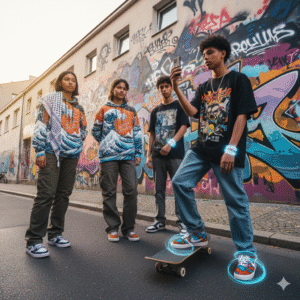
Walk through London’s Shoreditch, Paris’ Belleville, or Berlin’s Kreuzberg, and you’ll see it:
Ankara print hoodies 🟡
Hijabi girls in oversized Nike jackets + cargo pants 🧕
K-pop–inspired hairstyles with Afrobeat-inspired sneakers 🎶👟
Palestinian keffiyeh scarves worn alongside vintage Levi’s
👉 Streetwear today is the ultimate cultural hybrid.
📱 TikTok, Instagram & the Algorithm of Style
Fashion magazines used to dictate trends. Now, TikTok does. And Gen Z is making sure those trends are global.
Micro-Trends with Global Roots: A Mexican rebozo scarf, a Korean hanbok-inspired blouse, or a Nigerian gele headwrap can blow up on TikTok in days.
DIY & Remixing: Youth don’t just buy fashion—they make it their own. A Turkish-German teen in Berlin might thrift a jacket and sew on Syrian embroidery her grandmother taught her.
Hashtags as Movements: #DiasporaDrip, #ModestFashion, #AfroStreetwear—entire communities celebrate and push cultural pride online.
Call-Out Culture: If a brand appropriates without respect? TikTok drags them. And in 2025, brands actually listen. 🔥
✨ Human Moment: A 19-year-old Somali-British TikToker recently went viral for showing how she styles her abaya with sneakers and bucket hats—her video hit 4 million views, sparking a modest streetwear movement. 🧕👟
🎶 Music, Dance & Subculture as Style Engines
Fashion and music are inseparable. In 2025, Europe’s streetwear is shaped less by Paris catwalks and more by playlists and subcultures.
Afrobeat Influence: Artists like Burna Boy & Wizkid inspire Afro-centric streetwear—bold prints, bucket hats, and sneakers in Lagos-inspired colours. These vibes dominate London and Paris youth scenes.
Drill & Grime: London’s music scene continues to shape fashion—oversized puffer jackets, balaclavas, and sneakers are as much identity as clothing. 🎤
K-Pop & J-Pop Crossover: Korean oversized tailoring + anime graphics are flooding Berlin and Milan youth markets. ✨
Latin Trap & Reggaeton: Bad Bunny and Rosalia inspire colourful tracksuits, layered jewelry, and Caribbean-style street looks in Barcelona and Madrid. 🔥
👉 Streetwear isn’t copy-paste—it’s remix. European youth fuse these influences into looks that scream: we are global, we are hybrid, we are new.
🧕 Modest Fashion in the Streetwear Scene
Here’s something beautiful: modest fashion—once seen as “separate”—is now mainstream in youth streetwear.
Hijabi Streetwear Queens: Oversized hoodies, cargo pants, baseball caps over hijabs—these looks dominate Instagram feeds.
Cultural Pride: Young women style jilbabs or abayas with sneakers, proving modesty can be drip.
Brands Responding: Nike, Adidas, and smaller labels now create collections for modest wearers, often in collaboration with Muslim designers.
✨ Human Moment: At Copenhagen Fashion Week 2025, a modest fashion streetwear line received a standing ovation—showing the world this isn’t niche anymore.
🧵 Thrifting, Upcycling & DIY Diversity
Youth aren’t just consumers—they’re creators. Fast fashion is losing cool points, while thrift, vintage, and DIY win big.
Thrift Culture: In Paris and Berlin thrift shops, you’ll find teens mixing 90s Levi’s with traditional embroidered vests from Turkey or Morocco.
Upcycling as Activism: Reworking grandma’s sari into a crop top, or turning dad’s old dashiki into streetwear jackets. 🪡
Customization as Identity: Patches, embroidery, graffiti on denim—all cultural storytelling tools.
👉 Example: A Berlin collective of Turkish-German teens runs a streetwear label that only uses upcycled fabrics—mixing Adidas with Ottoman embroidery.
✨ Why it matters: Upcycling makes fashion personal and sustainable, but it also keeps cultural memory alive.
🌍 Streetwear as Cultural Resistance
Streetwear has always been political, and in 2025, it’s louder than ever.
Palestinian Keffiyehs: Worn not just as accessories, but as solidarity statements.
Black Lives Matter Influence: Pan-African colours and slogans still shape collections across Europe.
Feminist Streetwear: Women-led streetwear collectives across Europe push inclusive designs, often rooted in cultural traditions.
Queer Streetwear: Pride-inspired streetwear blends rainbow palettes with global cultural garments, rethinking gender and identity norms. 🏳️🌈
👉 Example: In Paris, a collective called Diaspora Drip stages pop-up fashion shows mixing dance, protest, and multicultural streetwear.
✨ Human Moment: For many young Europeans, wearing streetwear isn’t just about style—it’s about being seen and being heard.
🧡 Section Wrap-Up
Streetwear + youth culture = the heartbeat of cultural diversity in European fashion.
📱 TikTok spreads global styles in seconds.
🎶 Music subcultures drive silhouettes, colours, and vibes.
🧕 Modest fashion thrives in streetwear spaces.
🧵 Thrift, DIY, and upcycling turn heritage into everyday wear.
✊ Streetwear doubles as political expression and cultural pride.
Challenges – Appropriation, Commercialization & Authenticity
Multicultural Future of European Style 2025| Amazing Facts by Theinsidetune
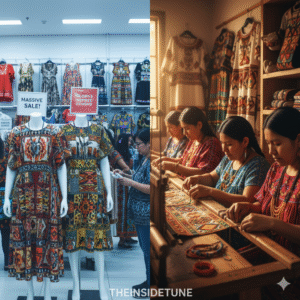
🧩 The Double-Edged Sword of Diversity
Cultural diversity in fashion is beautiful 🌍—but it’s not simple. On one hand, it allows stories, traditions, and communities to shine on global stages. On the other hand, it risks exploitation if brands reduce sacred symbols into shallow aesthetics.
The question is: When is it appreciation, and when is it appropriation?
That line is blurry, and it sparks heated debates every season. 🔥
Multicultural Future of European Style 2025| Amazing Facts by Theinsidetune
🎭 Cultural Appropriation vs. Appreciation
Cultural appropriation happens when fashion borrows symbols, clothing, or traditions without context, credit, or respect.
Examples of past issues:
High fashion using Indigenous headdresses as “festival chic” accessories 🪶.
Luxury brands printing “tribal” patterns with no reference to their origins.
Designers calling kimonos, saris, or dashikis “exotic” costumes instead of cultural garments.
Appreciation, on the other hand, means celebrating culture with credit, collaboration, and respect. It looks like:
Working with artisans and paying them fairly.
Acknowledging the history and meaning behind cultural symbols.
Inviting people from that culture into the creative process.
✨ Human Example: When Stella Jean (Haitian-Italian designer) works with Haitian and African artisans, she highlights their names and stories—not just their fabrics. That’s appreciation.
👉 Why it matters: The difference is whether the community being referenced actually benefits—or just watches from the sidelines.
💰 Commercialization: Turning Culture Into Commodity
Let’s be honest: fashion is a business. And businesses love trends. The problem is when cultural diversity is treated like just another “trend” to sell handbags.
Fast Fashion Copycats: In 2025, big chains still rip off artisan embroidery, Indigenous beadwork, or African prints—mass-producing them without acknowledgment. 🏭
Luxury “Exoticism”: High-end brands sometimes showcase “tribal” or “ethnic” vibes without saying where they come from, reducing deep traditions to shallow aesthetics.
Short-Lived Trends: What’s sacred in one culture (like prayer beads or headscarves) might be turned into a “seasonal accessory” that disappears after the hype dies down.
✨ Human Example: A TikTok thread went viral in 2025 when a major European fast-fashion chain released “festival jewelry” identical to Maasai beadwork—but with no Maasai involvement. The backlash forced the brand to apologize.
👉 Why it matters: If cultural diversity becomes just a sales gimmick, it loses meaning—and hurts the very communities it claims to celebrate.
🕊️ Authenticity & Representation: Who Tells the Story?
Representation is improving, but here’s the hard truth: many cultural fashion influences are still filtered through white, Western voices.
The Token Model Problem: One hijabi model or one Black model in a campaign doesn’t equal diversity—it can feel like a checkbox ✅.
Designers Behind the Scenes: Even if runways look diverse, creative directors are still often white Europeans. Who gets to hold the power?
Narrative Control: Is the story of a garment told by the community it comes from—or rewritten by fashion PR teams?
✨ Human Example: At Milan Fashion Week 2025, critics pointed out that a luxury brand used African wax prints—but no African designers or artisans were involved in the process. The collection felt like “costume” instead of collaboration.
👉 Why it matters: Diversity without authentic voices is just decoration. True change means putting diverse people in decision-making roles—not just on posters.
⏳ The Pressure of “Always On” Activism
Here’s another challenge: in 2025, fashion brands are under constant public scrutiny.
Cancel Culture Pressure: A single misstep—like misusing a sacred motif—can cause global backlash on TikTok overnight.
Performative Activism: Some brands “celebrate diversity” during Pride Month 🌈 or Black History Month ✊🏿, but go quiet the rest of the year.
Exhaustion for Marginalized Designers: Designers from underrepresented communities are often expected to be spokespeople for their entire culture, which is unfair and exhausting.
✨ Human Example: A South Asian designer in London admitted in an interview: “Every collection I make, I’m asked if it’s ‘about my culture.’ Sometimes, I just want to make clothes.”
👉 Why it matters: Diversity shouldn’t become another box to tick—or a burden on the very people it’s supposed to uplift.
🌱 Sustainability vs. Exploitation
Remember how cultural diversity and sustainability often overlap? That’s a strength—but also a challenge.
Exploitation Risk: Artisans in India, Morocco, or Africa are sometimes underpaid while their crafts sell for thousands in Paris.
Mass Production Dangers: When cultural motifs are mass-produced, they lose their meaning and damage the environment.
The Slow Fashion Struggle: Consumers love artisan-made clothes but balk at higher prices, making it hard for authentic slow-fashion brands to survive.
✨ Human Example: A Peruvian weaving collective collaborated with a French brand in 2025. The pieces were stunning—but cost €2,000. Locals asked: “Why can’t sustainable diversity also be affordable?”
👉 Why it matters: Cultural celebration must be ethical and accessible, or it risks creating elitist “diversity for the rich.”
🧡 Section Wrap-Up
Cultural diversity is beautiful, but not without challenges. In 2025, fashion faces big questions:
🎭 How do we ensure appreciation, not appropriation?
💰 How do we stop culture from being commodified?
🕊️ Who gets to tell the stories—and hold the power?
🌱 How do we balance sustainability with accessibility?
The Future – Where Cultural Diversity in European Fashion is Heading (2030 and Beyond)
Multicultural Future of European Style 2025| Amazing Facts by Theinsidetune
🚪 Opening the Door to Tomorrow
Fashion has always been forward-looking. A hemline rising in the 1920s hinted at women’s liberation. Bold prints in the 1970s mirrored social revolutions. So what will 2030’s fashion say about us?
Here’s the good news: cultural diversity isn’t a “trend” anymore. It’s the backbone of European fashion. The question isn’t if it stays, but how it evolves. And the signs we see in 2025 give us some exciting clues.
🌍 Multicultural Runways as the Norm
By 2030, diversity on runways will no longer be a headline—it will be the default.
Models of Every Identity: Hijabis, plus-size, disabled, trans, Black, Asian, Latinx, Indigenous—all normalized. No tokenism, just reality.
Designers from Everywhere: Expect Nigerian, Pakistani, Vietnamese, Brazilian, and Somali creative directors leading French, Italian, and British houses.
Global Fashion Capitals: While Paris and Milan will remain iconic, Lagos, Mumbai, Seoul, and São Paulo will rise as equal cultural forces. European fashion will have no choice but to collaborate with them.
✨ Vision: A Dior couture show co-designed by Paris ateliers and Indian artisans in New Delhi. 🌸
🤝 Collaboration, Not Extraction
The future of fashion lies in partnerships, not plunder.
Fair Collaborations: European houses will work hand-in-hand with artisan communities in Africa, Asia, and Latin America, giving credit and profits.
Cultural Equity Labels: By 2030, we may see certification labels (like Fair Trade) for cultural collaborations—ensuring communities are paid and respected.
Shared Platforms: Instead of “borrowing” motifs, big brands will sponsor artisan groups to present their work alongside luxury collections.
✨ Vision: A Milan Fashion Week schedule where a Maasai beadwork collective gets the same spotlight as Prada. 🧡
🤖 Tech + Tradition Fusion
Technology is moving at lightning speed. The fashion future will mix the oldest crafts with the newest tech.
AI as Heritage Keeper: AI can help digitize endangered patterns, stitches, and techniques—saving them from extinction. Imagine a database of ancient Moroccan embroidery accessible to young designers in Paris.
Virtual Fashion Shows: By 2030, metaverse runways will let anyone—whether in Lagos, Lisbon, or Lahore—attend a Paris show live in VR glasses. 🌐
Digital Couture: Avatars in games will wear virtual saris, dashikis, and ponchos created by real artisans, merging heritage with the digital economy.
Smart Textiles: Fabrics that glow, change color, or adapt—combined with traditional motifs. A Palestinian tatreez pattern that lights up at night? Not impossible.
✨ Vision: A Balenciaga collection where physical clothes are made in collaboration with Guatemalan weavers—and their digital twins exist in the metaverse.
🌱 Sustainability Through Culture
By 2030, sustainability won’t just be about “eco-friendly.” It will mean culturally sustainable fashion.
Heritage Crafts as Green Fashion: Slow-made, handwoven, natural-dyed textiles will replace fast-fashion polyester.
Circular Global Fashion: Old garments recycled with heritage techniques—like Japanese sashiko embroidery for repair or Indian kantha quilting for reuse.
Global Repair Culture: Instead of buying new, people will take old items to local craftspeople for mending, blending sustainability with cultural revival.
✨ Vision: Instead of H&M fast fashion, malls in 2030 may host artisan repair and customization hubs. 🧵
🧕 Modest, Inclusive & Fluid Futures
Identity will keep expanding. Fashion in 2030 will go beyond “male/female,” “Western/non-Western.”
Modest Fashion Mainstreamed: Abayas, hijabs, turbans, and saris will no longer be “niche”—they’ll be seen on European high streets like jeans and tees.
Gender Fluidity Across Cultures: More designs will highlight global traditions that were always non-binary—like sarongs, kaftans, or robes.
Multi-Identity Wardrobes: People will mix cultural codes daily. A 2030 teen might wear VR sneakers, a thrifted Peruvian poncho, and a 3D-printed shirt in the same outfit.
✨ Vision: European fashion schools teaching “global dress history” alongside tailoring, so future designers understand saris and kimonos as much as suits.
💬 Youth Power & Political Fashion
Gen Z and Gen Alpha will be running the show by 2030—and they will demand authentic, political, cultural fashion.
Streetwear Activism: Political statements embedded in clothing—Palestinian keffiyehs, feminist embroidery, queer fashion collectives.
Global Music Influence: Afrobeat, K-Pop, reggaeton, drill—all still driving silhouettes and colors. 🎶
Fashion as Protest: Just like Extinction Rebellion used protest art, expect youth collectives using fashion shows as activism platforms.
✨ Vision: Berlin Fashion Week 2030 featuring a runway staged as a protest march—part art, part activism, part style. ✊
🏛️ Decolonizing Fashion
This is the big one. Fashion’s colonial history is undeniable. By 2030, Europe may be forced to reckon with it.
Acknowledging the Past: Brands will have to openly admit histories of exploitation—cotton, silk, and patterns taken without credit.
Cultural Restitution: Just as museums are returning artifacts, fashion may begin funding and supporting communities whose crafts were historically exploited.
Shared Ownership: Future luxury might involve joint ownership—where African, Asian, or Indigenous communities co-own parts of European fashion houses.
✨ Vision: A Chanel collection in 2030 that openly states: “This embroidery is from Gujarat, India. The artisans are credited, paid, and co-listed as collaborators.” 🌸
Conclusion – A Tapestry Woven Together

Multicultural Future of European Style 2025| Amazing Facts by Theinsidetune
🧵 Fashion as a Story We All Wear
If you’ve followed this journey from history to the runways of 2025, through challenges and dreams of 2030—you already know: fashion is never just clothes.
It is migration sewn into seams. It is colonization stitched into embroidery. It is joy, protest, spirituality, and survival embroidered into patterns that cross oceans. Fashion is the world in fabric.
And Europe, once the center of a narrow, Eurocentric vision of style, is now opening its doors to the world—not as an “exotic” guest, but as an equal partner.
🌍 Key Threads We’ve Explored
History’s Echo: From colonial trade routes to diaspora communities, Europe’s past shaped today’s diverse style landscape.
Runways Reimagined: Diversity is no longer optional—it’s expected. Hijabs, saris, Ankara prints, and indigenous embroidery walk alongside couture gowns.
Streetwear & Subcultures: TikTok teens in Berlin or Paris remix global styles faster than fashion houses can keep up. 🕺
Sustainability Meets Heritage: Artisan crafts and slow fashion are no longer just “ethical,” they’re the future of style.
Challenges: Appropriation, tokenism, and commercialization remain real risks, demanding accountability.
The Future: By 2030, collaboration, inclusivity, and tech will make cultural diversity the default language of fashion.
✨ Why This Matters Beyond Fashion
Here’s the secret: when we talk about cultural diversity in fashion, we’re not just talking about outfits. We’re talking about who gets seen, who gets heard, and who gets valued.
A hijabi model on a Paris runway tells a young girl in Brussels: “You belong.” 🧕
A Ghanaian print in a Milan boutique tells an artisan back home: “Your craft matters.”
A gender-fluid sari in London whispers to a teen: “Be yourself. The world is ready.” 🌈
Fashion mirrors society. A more diverse wardrobe signals a more inclusive world.
🕊️ Challenges That Remain
Let’s not romanticize it—problems remain.
Cultural symbols still risk exploitation.
Big brands can still profit more than communities.
Representation can slip into tokenism.
But the difference in 2025 is that people notice—and call it out. The watchdog isn’t just critics anymore, it’s all of us with phones, hashtags, and sharp cultural awareness. 📱⚡
🚀 Looking Ahead
Picture 2030:
A Paris runway where Indigenous Amazonian artisans are not “referenced” but co-presenters.
Digital fashion archives that let anyone access centuries of cultural crafts, responsibly and fairly.
Teenagers wearing hand-me-down kimonos mixed with 3D-printed jackets, seeing no contradiction in mixing old and new, East and West, tradition and tech.
European fashion schools teaching African, Asian, and Indigenous dress history as part of their core curriculum—not as “extras.”
That’s not a utopia. That’s a very possible tomorrow.
💬 Final Reflection
Cultural diversity in European fashion is not just a look—it’s a shift in values. It means moving from extraction to collaboration, from tokenism to inclusion, from spectacle to respect.
It means realizing that beauty doesn’t have one language, one body, or one geography. Beauty is a conversation—a fabric woven from countless threads.
And the most exciting part? We’re only at the beginning of this story.
🌟 3-Line Takeaway
Fashion in 2025 proves that diversity isn’t a passing trend—it’s the heartbeat of European style.
By 2030, collaboration, inclusivity, and cultural respect will reshape the industry at every level.
The future of fashion is not “European” or “global”—it’s all of us, together. 🌍👗✨
💡 So next time you slip into a jacket, a scarf, or a pair of sneakers—ask yourself: what stories are woven into this fabric? And whose voice does it carry?
Because in the end, fashion isn’t just what we wear.
It’s who we are. 💖


